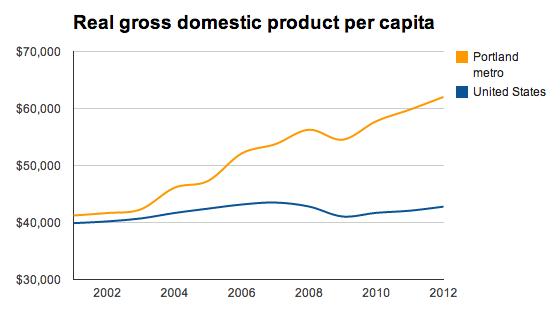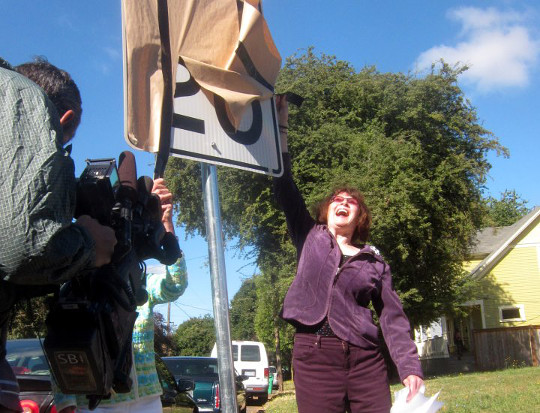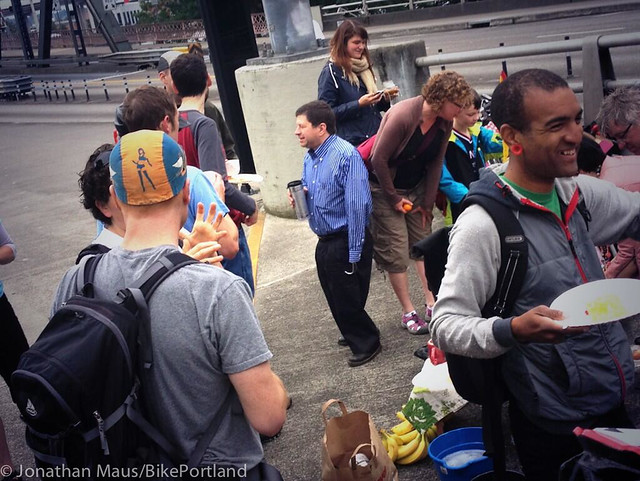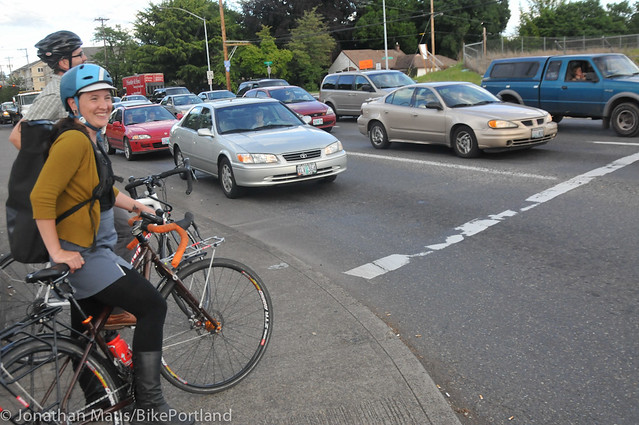This morning, we looked back at the stories that made it big. Before we turn the page to 2014, let’s look at four stories that can fall through the cracks at the end of a day, but are too big to ignore at the end of a year.
Maybe 10 million times in the last year, a Portlander got on a bicycle to go somewhere. Here’s how many of them survived it: every single one.
There were several serious collisions, covered here on the site, including one major hit-and-run that remains unsolved. But the number-one reason Portland is the country’s best big city for biking is that this is, compared to any other large U.S. city and lots of the smaller ones, an extremely safe place to ride a bicycle.
This isn’t a new feat for Portland: the city also avoided any bike-related fatalities in 1999, 2000, 2002, 2006, 2008 and 2010. That’s a safety record that’s nearly unmatched from coast to coast, and it’s something to raise a glass for this evening.

Why is this a bike story? Because in the national psyche and in our city’s own, Portland means biking and biking means Portland. When people think Portland is an economic basket case, they look for scapegoats. In recent years, bikes have gotten blamed.
That’s always been nonsense, but numbers released this year should nail that coffin shut for good.
When Portlandia premiered in January 2011, it turns out, the Portland area was already swinging out of its slump. This September, the Bureau of Economic Analysis announced that only two major metro areas in the country (San Francisco and New Orleans) saw faster real GDP growth per capita last year than Portland. Since 2001, no major metro in the country has done better.
You might have also heard a storyline claiming that Portland mooches off job growth in its more auto-oriented western suburbs. That’s baloney, too. Washington County has added 11,700 jobs since 2011 (4.7 percent growth), and that’s great. Multnomah County, meanwhile, has added 20,600 jobs (4.6 percent growth).
Even more intriguingly, there’s plenty of evidence that the things bikes have helped do for the Portland area — lowered living costs, pollution and sprawl — have been a big driver for our relative economic success.
“What we have is a skill-based economy where we need smart people,” state economist Christian Kaylor said in an interview Tuesday, explaining why Multnomah County has been “dominating” Oregon job creation over the last two years. “Hospitals need doctors, engineering companies need engineers, computer programming companies need computer programmers. Those companies don’t run on coal, they don’t run on timber, they don’t run on a port. What they care about is highly educated people — that’s the resource they need. That’s their oxygen. So who wins in that? The community that can attract highly educated people.”
On that measure, Kaylor said, Portland has been lapping the field. The city has absorbed 45 percent of the region’s population growth since 2007, quadruple its rate in the 90s. More than half of new arrivals have college degrees, and employers have been following them into town.
“It’s as good for economic development, I think, as having a major university,” Kaylor said. “This is something we haven’t seen since the 1940s, with the Liberty Shipyards, when the City of Portland is growing economically faster than the rest of the region.”
The Portland area is far from an economic paradise, and like every U.S. city it struggles to help everyone share in the wealth it has. But in 2014, resolve never to let anybody get away with arguing that pro-bike policies have been stifling Portland’s economic growth. It’s just the opposite.

city’s first 20 mph speed limit signs.
(Photo by M.Andersen/BikePortland)
When it comes to using protected and buffered bike lanes to make big corridors bike-friendlier, Portland has fallen well behind the leading U.S. cities (though it did add 4 miles of new buffered bike lanes in 2013, most prominently a 2-mile stretch of Southwest Beaverton-Hillsdale Highway).
But Portland does still have a solid claim to bike-infrastructure leadership in the United States: its neighborhood greenway network, on which it continues to remove center lines (as it did this year on outer Alberta, inner Ankeny and inner Flint), flip stop signs and install about 1,600 new “20 mph” signs in recognition of the network’s new, lower speed limit.
If neighborhood greenways have a shortcoming, it’s that a lot of beginning bikers don’t even realize that they form an interconnected grid. But for those of us who are in on the secret — and thanks to the city’s booming Safe Routes to Schools program, more and more of us are — the greenways are a great way to get around. That’s why Seattle, Chicago and Washington County are rushing to imitate them.

(Photo by J.Maus/BikePortland)
Spend a minute reflecting on this string of events: Before leaving office, the pro-bike politician who oversaw a city’s transportation policy for eight years tries to install his even more pro-bike protege (who also shared some of his boss’s sharp-elbowed style and ethically problematic actions) to run the department after he leaves. The new transportation chief fires or lays off several senior staffers, reorganizes the bureau and announces significant strategic reforms but his unpopularity comes home to roost and the new mayor forces the new guy from office.
In another city, that would be a disaster for biking. But here in Portland, the extremely pro-bike politician was succeeded by two moderately pro-bike politicians, who installed a publicly pro-bike director with a more low-key style.
“Bicycle” isn’t currently a word you’ll hear much in City Hall. That’s a big change and a sad one. But it’s remarkable that the epic political crossfire that surrounded Mayor Sam Adams’ departure hasn’t been significantly worse news for people who use bikes. The fact that it hasn’t is a tribute to the fact that, when you come right down to it, it’s become totally mainstream in Portland to think that bicycles are awesome.
That’s as good a foundation as any to build the future on.


